Home | Airshows | The Hangar | Nostalgia | Links
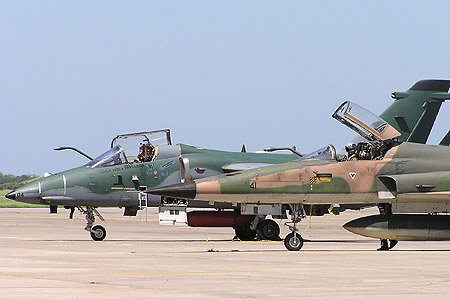 Brazilian
blend
Brazilian
blend
Guilherme Bystronski reports from Santa Cruz AB, Brazil on one of the FAB's annual open days. All photography by the author.
Every 23 October, the Brazilian Air Force (Força Aérea Brasileira - FAB) commemorates the 'Aviator and Brazilian Air Force's Day'. This date was not chosen at random, because it was on 23 October 1906 that its aviation pioneer, Alberto Santos-Dumont, performed his first flight with a heavier-than-the-air machine, the 14Bis, in France. Although many countries do not recognise this flight as being the first ever with such a machine (with credit being given instead to the Wright Brothers' flight in December 1903, whose Wright Flyer needed a catapult to take-off), in Brazil Santos Dumont is called the father of flight, and is indeed a national hero. To celebrate this very important achievement, the FAB opens its airbases around Brazil to the general public in the month of October, allowing them to visit their hangars, and watch performances flown by their aeroplanes. In 2003 the Santa Cruz AB Open House was scheduled to happen on the 26th, which was the last Sunday of the month. Being only 40 miles away from downtown Rio, it usually attracts a reasonable amount of people, many of whom can't be considered aviation enthusiasts.
|
Brazilian
beauties
|
 |
 |
 |
 |
 |
 |
 |
 |
 |
 |
 |
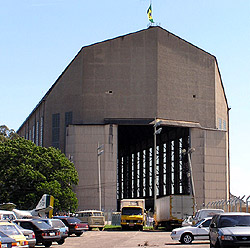 Santa
Cruz AB has a rich and colourful history. It was originally a farm where
the Portuguese and Brazilian royal families spent a lot of their free
time in the 19th Century. In 1933, however, things changed dramatically
when some Germans affiliated with the company Luftschiffbau Zeppelin came
to Brazil to choose a place where they could build a hangar large enough
to house dirigibles. In March 1934 concession was given to establish a
regular flight between Brazil and Germany, and the hangar was built by
a Brazilian company according to German plans. The hangar was completed
on 26 December 1936, and a regular line that linked Frankfurt to Rio was
soon a reality. Unfortunately, after the tragic demise of the Zeppelin
Hindenburg in Lakehurst, New Jersey, the flights were discontinued after
only nine of them were completed (four by the Hindenburg and five
by the Graf Zeppelin). It's the only such hangar left in the world,
since the other two (in Germany and in the United States) do not exist
anymore.
Santa
Cruz AB has a rich and colourful history. It was originally a farm where
the Portuguese and Brazilian royal families spent a lot of their free
time in the 19th Century. In 1933, however, things changed dramatically
when some Germans affiliated with the company Luftschiffbau Zeppelin came
to Brazil to choose a place where they could build a hangar large enough
to house dirigibles. In March 1934 concession was given to establish a
regular flight between Brazil and Germany, and the hangar was built by
a Brazilian company according to German plans. The hangar was completed
on 26 December 1936, and a regular line that linked Frankfurt to Rio was
soon a reality. Unfortunately, after the tragic demise of the Zeppelin
Hindenburg in Lakehurst, New Jersey, the flights were discontinued after
only nine of them were completed (four by the Hindenburg and five
by the Graf Zeppelin). It's the only such hangar left in the world,
since the other two (in Germany and in the United States) do not exist
anymore.
Today Santa Cruz AB is home to a number of fighter, attack and training squadrons, which belong to the 1º GAvCa, the 1º/16º GAv, and the 2º ELO groups. It is responsible for defending the most important cities and industrial regions in Brazil, and it has the most decorated squadron in Brazilian history, the Senta a Púa Squadron (1º/1º GAvCa). It flew in WWII in the Mediterranean together with the 350th Fighter Group, and was equipped with the rugged and dependable P-47 Thunderbolt. Today this group flies F-5E Tiger IIs, and continues to keep the traditions of their predecessors in Italy.
|
Brazilian
Air Force begins fighter jet update programme
|
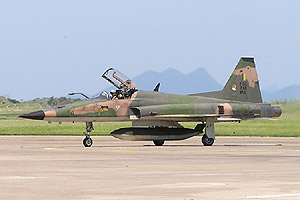 |
|
A short flight lasting only a few minutes under a cloudy sky in Sao Jose dos Campos on 4 December marked the official presentation to the Air Force Command of the first F-5BR jet aircraft, a modernised version of the supersonic F-5E, the Brazilian Air Force's (FAB's) main tactical fighter plane. The process of updating the technology on the 46 unit fleet is being carried out by Embraer [Brazilian Aeronautics Company] with the participation of the Israeli firm Elbit. The contract is worth $285m. |
| The slim F-5BR jet, painted in the FAB's new camouflage pattern, had only a discreet roll-out two days ago, "but it must be seen as the starting point for the programme aimed at giving Brazil the continent's most powerful military aviation by the year 2010", says Professor Sidney Amaral of the Latin Centre for Higher Studies (Celes). |
| The project, authorised by former President Fernando Henrique Cardoso in July 2000, involves an initial investment of an estimated $3.5bn and includes, in addition to the purchase of 12 fourth-generation supersonic fighters to re-equip the 1st Air Defence Group (GDA), modernisation of the old F-5Es and Fs (E for combat; F for training and attack) and the 53 AMX fighter-bombers - an additional order totalling $280m. |
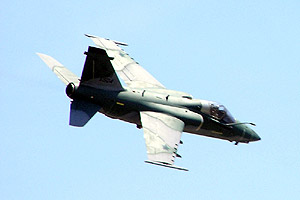 |
| In the country's strategic north and northeast regions, which are covered by the network of radars and sensors known as the Amazon Region Surveillance System (Sivam), the air force fighting arm will start being equipped with delivery of the first of a batch of 76 ALX-Super Tucano turboprops, a deal worth approximately $420m. There is also a complete development package for P-3 Orion maritime patrol aircraft and C-130 transport planes, as well as the purchase of 12 Spanish medium-size C-295 cargo planes. |
| From Brazilian news agency 'Estado '. |
The show itself was a good one, with every single group contributing something to the flying displays, and some aeroplanes coming from other airbases. The airshow started with an AMX (A-1) display, which greeted all the arriving public (including myself) with a nice array of low and fast fly-bys. This particular aeroplane, 5504, has recently undergone a paint scheme change, and now sports the new camouflage which will be applied to all AMXs in Brazil. Although the new scheme isn't particularly striking, it looks better compared to the grey one used before, and to the ones most airforces use around the world.
After the AMX display, a KC-130 Hercules arrived quietly from Galeão AB. This aeroplane was later opened to the general public, and a long queue formed beside it, proving that even a veteran like the Hercules can still attract the public's interest. But better things were happening in the air, when the first of many F-5Es was scrambled to show the still very good performance of this nimble aeroplane. Although they are already veterans, the Tigers can still be flown with enthusiasm, and many low and fast flybys were more than enough to dissipate any doubts. Some were even equipped with arresting gear, but I guess no one is trying to land one of those on an aircraft carrier...
Star of the day, undoubtedly, was Ex-Kuwaiti AF AF-1A (TA-4KU) Skyhawk from the Navy's VF-1 Falcões (Hawks) Squadron. Of the 23 Skyhawks purchased by Brazil in 1997, only three are two-seaters, N-1021 being one of those. It was very nice to see the old A-4 still in the air, and to know that the Skyhawk is going to be our Navy's main airborne strike asset for years to come.
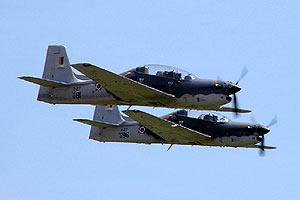 Other
interesting displays were provided by T-27 and A-27 Tucanos (the A-27
being the strike version of the regular trainer, developed in Brazil),
a P-95A (EMB-111 Bandeirante, modified to perform maritime patrol duties),
a Police Esquilo (HB.350) and a EU-93A (Hawker 800-XP), which is responsible
for flight inspection missions.
Other
interesting displays were provided by T-27 and A-27 Tucanos (the A-27
being the strike version of the regular trainer, developed in Brazil),
a P-95A (EMB-111 Bandeirante, modified to perform maritime patrol duties),
a Police Esquilo (HB.350) and a EU-93A (Hawker 800-XP), which is responsible
for flight inspection missions.
So it was a very interesting Sunday to say the least, the Mirage IIIBR (F-103) being the only major absence. But there's always next year for that, April being already circled on my calendar. See you then!
All relevant historic info was taken from the FAB website, www.fab.mil.br, with exception of the Lakehurst, NJ disaster, which can be found elsewhere on the web.
Home | Airshows | The Hangar | Nostalgia | Links